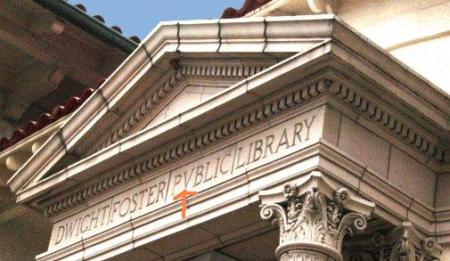For nearly one hundred years, people entering the library here in Fort Atkinson have been admiring the columns and stonework at the entryway of the Dwight Foster Public Library.
The name of the library, beautifully cut in the stone, makes an elegant statement. It reads: DWIGHT FOSTER PVBLIC LIBRARY.
So why does it say PVBLIC instead of PUBLIC? What’s that all about?
I’ve been asked about that many times over the years. People have suggested different reasons that the engraving above the front doors uses a “V” rather than a “U.” One thought is that it was easier to carve straight lines than curved ones. That seems plausible. But then what about the letter “C”? That’s a curved letter if ever I saw one.
The best explanation I’ve found is at the Henderson County Public Library website. They are a Pvblic Library too.
Here is what it says:
According to the World Book encyclopedia, U was adopted from the Greek letter Y. The Romans dropped the bottom stroke and wrote the letter as V. This was used for both the consonant sound V and the vowel sound U. Some time around 900 A.D. people began to use V at the beginning of a word and U in the middle of a word. It was during the time between 1400 A.D. and 1600 A.D. that U became the letter commonly used for the vowel sound.
There was a Renaissance of the Classical style of architecture in the United States from 1890-1940. William R. Ware, the founder of M.I.T.’s School of Architecture, taught a style that he called American Vignola. (Vignola was an Italian architect who codified the standards for Classical Architecture in his work Rules of the Five Orders of Architecture)…
In the early 1900s, it was common for educated men to be taught both Greek and Latin. Therefore the people involved with the design of this building and many others during this American Renaissance more than likely would have known the Classic Roman alphabet used the symbol V for both U and V.
We are not the only library to be a “pvblic” library. Pictures have been found of several other libraries where a V is substituted for a U. While their architectural style does not always match our Classical columns, domes and pediments, most of them were built during this time of American Vignola. So it is accurate to say that we were built during a time when architects and builders were embracing Classic themes. Therefore it is very likely that the engraving reads “Henderson Pvblic Library” because it was in accordance to what was popular in the architectural world at the time our library was built….
The oldest portion of our library was built in 1916. So the timing is exactly right for this explanation. And it makes sense that it was, indeed, an architectural statement…a “design thing.” Henry E. Southwell of Chicago, son-in-law of Dwight Foster, who donated the funds to build a new library had only two stipulations attached to his gift. One was that the library be of “good design” and the other was that it be named in honor of Dwight Foster.
We’re happy to report, all these years later, that our library is still named Dwight Foster…and remains committed to the “good design” stipulation.
So DWIGHT FOSTER PVBLIC LIBRARY it is…and shall remain. We’re good with embracing our “V”niqueness.

Lazy stonecutter? Poor speller? Or good designer?

 gical changes mean for libraries it is interesting to note what other libraries are doing to respond to the trends. An interesting article entitled:
gical changes mean for libraries it is interesting to note what other libraries are doing to respond to the trends. An interesting article entitled: 








